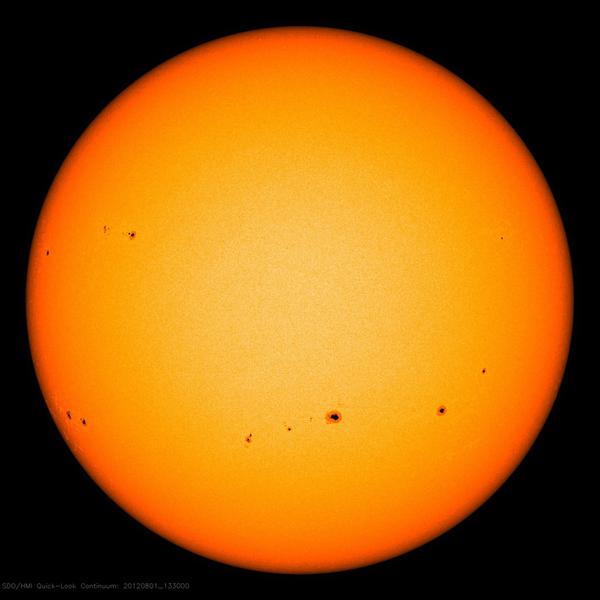This page describes an image Sunspots
Image caption:
In this image the sun peppered with groups of sunspots over almost nine days between July and August 2012. The sunspots seen in this image have been sources of the solar flares and coronal mass ejections (CME). In this image particulary, the sun is approaching solar maximum in its cycle (solar cycle), where we see many spots forming along the suns' equator. These sunspots and activity are seen in the southern hemisphere, before then most of the activity was on the northern hemisphere.
Scroll to captions in other languages
Image credit:
NASA/SDO/HMI Credit Link
Related glossary terms:
Stellar Activity
, Sun
, Sunspot
Categories:
The Sun
Image license: Public Domain Public Domain icons
The media file captions presented on the OAE website were written, translated and reviewed by a collective effort from the OAE, the OAE Centers and Nodes, the OAE National Astronomy Education Coordinators (NAECs) and other volunteers. You can find a full list of credits for our translation project here. All media file captions are released under a Creative Commons CC BY-4.0 license and should be credited to "IAU OAE". The media files themselves may have different licenses (see above) and should be credited as listed above under "credit".
If you notice a factual error in this caption or an error in any of its translations then please get in touch.
Captions in Different Languages:
Image caption: এই ছবিতে সূর্য জুলাই এবং আগস্ট ২০১২ এর মধ্যে প্রায় নয় দিন ধরে সূর্যের দাগের সাথে মিশেছে। এই ছবিতে দেখা সূর্যের দাগগুলি সোলার ফ্লেয়ার এবং করোনাল ভর ইজেকশন (সিএমঈ ) এর উৎস। এই চিত্রটিতে বিশেষ করে, সূর্য তার চক্রে (সৌরচক্র) সৌর সর্বাধিকের কাছে আসছে, যেখানে আমরা সূর্যের বিষুব রেখা বরাবর অনেকগুলি দাগ তৈরি করতে দেখি। এই সূর্যের দাগ এবং ক্রিয়াকলাপগুলি দক্ষিণ গোলার্ধে দেখা যায়, এর আগে বেশিরভাগ ক্রিয়াকলাপ উত্তর গোলার্ধে ছিল।
Image credit: নাসা/এসডিও/এইচএমআই
Related glossary terms: Stellar Activity , Sun , Sunspot Caption translation status: Not yet approved by a reviewer
Caption translators: Raktim Mukherjee
Image caption: Sur cette image, le Soleil est parsemé de groupes de taches solaires pendant près de neuf jours entre juillet et août 2012. Les taches solaires visibles sur cette image sont à l'origine des éruptions solaires et des éjections de masse coronale (CME). Sur cette image en particulier, le Soleil approche du maximum solaire de son cycle (cycle solaire), où l'on voit de nombreuses taches se former le long de l'équateur du Soleil. Ces taches et cette activité sont visibles dans l'hémisphère sud, alors qu'auparavant, l'essentiel de l'activité se situait dans l'hémisphère nord.
Image credit: NASA/SDO/HMI
Related glossary terms: activité stellaire , Soleil , Tache solaire Caption translation status: Not yet approved by a reviewer
Caption translators: Rulx Narcisse
Image caption: In questa immagine il Sole è stato punteggiato da gruppi di macchie solari per quasi nove giorni tra luglio e agosto 2012. Le macchie solari osservate in questa immagine sono state fonte di brillamenti solari ed espulsioni di massa coronale (CME). In questa immagine, in particolare, il Sole si sta avvicinando al massimo solare del suo ciclo (ciclo solare), dove vediamo formarsi molte macchie lungo l'equatore del Sole. Queste macchie solari e l'attività sono visibili nell'emisfero meridionale, mentre prima la maggior parte dell'attività aveva luogo nell'emisfero settentrionale.
Image credit: NASA/SDO/HMI
Related glossary terms: attività stellare , Macchia solare , Sole Caption translation status: Approved by a reviewer
Caption translators: Giuliana Giobbi
Caption reviewers: Rosa Valiante, Rodolfo Canestrari
Image caption: 在这张图片中,太阳在2012年7月至8月的近九天里布满了成群的太阳黑子。这张图片中看到的太阳黑子是太阳耀斑和日冕物质抛射(CME)的源头。特别是,在这张图片中,太阳正接近其周期(太阳周期)中的太阳活动最大值,我们可以看到许多黑子沿着太阳赤道形成。这些太阳黑子和活动出现在太阳的南半球,在此之前,大部分活动都发生在北半球。
Image credit: NASA/SDO/HMI
Related glossary terms: 太阳 , 太阳黑子 , 恒星活动 Caption translation status: Not yet approved by a reviewer
Caption translators: Lin Shijie
Image caption: 在這張圖片中,太陽在2012年7月至8月的近九天里布滿了成群的太陽黑子。這張圖片中看到的太陽黑子是太陽耀斑和日冕物質拋射(CME)的源頭。特別是,在這張圖片中,太陽正接近其週期(太陽週期)中的太陽活動最大值,我們可以看到許多黑子沿著太陽赤道形成。這些太陽黑子和活動出現在太陽的南半球,在此之前,大部分活動都發生在北半球。
Image credit: NASA/SDO/HMI
Related glossary terms: 太陽 , 太陽黑子 , 恆星活動 Caption translation status: Not yet approved by a reviewer
Caption translators: An automated transliteration from the simplified Chinese translation by - Lin Shijie









